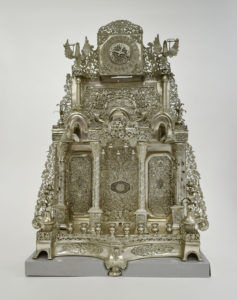Hanukkiyah (Hanukkah Lamp)
Central Europe, early nineteenth century
Silver appliqué, h. 30 x w. 24 in.
Cincinnati Skirball Museum, gift of Benjamin S. Katz, 27.74
Hanukkah is a postbiblical festival that recalls the deliverance of the Jews from the tyranny of the Syrian-Greek government in 165 BCE. This triumph is the first time in recorded history that a people fought for religious freedom. As the Jews entered Jerusalem and prepared to rededicate the desecrated Temple, they did not have enough oil to rekindle the lamps whose light would signify God’s eternal presence with them. According to the apocryphal book of Maccabees, a miracle occurred; a small vial of oil lasted eight days, long enough to find more oil and keep the lamps burning continuously.
The struggle to liberate the Holy Temple and the victory of the Maccabees over King Antiochus and his troops are recalled during Hanukkah by lighting a Hanukkiyah, or Hanukkah lamp, for eight days; each evening one ore light is lit, so that on the eighth day all the lights are burning. A ninth light, the shamash (servant), is used to light the others.
Hanukkiyot are beautifully designed in a wide range of styles from more traditional candelabra shapes to contemporary structures. This rococo-style lamp emulates the decorative architecture and interiors of eighteenth-century synagogues. Set on claw feet, the back plate and sides are impressed with motifs of flowers, leaves, and birds. Columns flanking an ark-like construction reflect the desire to identify the lamp with the ancient Temple in Jerusalem. An unusual component of this lamp is a clock with Hebrew numerals. The donor of this Hanukkiyah was president of The Gruen Watch Company in Cincinnati, active from about 1894 to 1958, and formerly one of the largest watch manufacturers in the United States. This connection may explain the attraction to a Hanukkiyah with a clock.
Publications:
Artistic Expressions of Faith in Judaism, Christianity, and Islam, ed. Abby S. Schwartz, 1997, p. 7.

